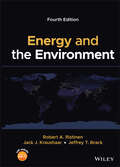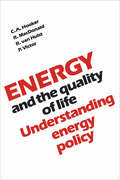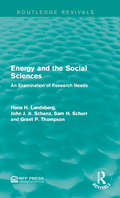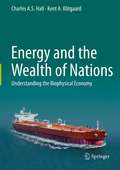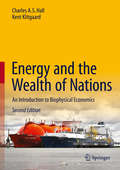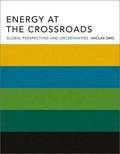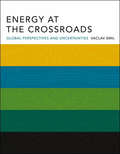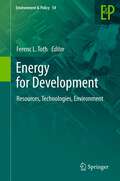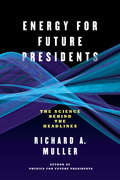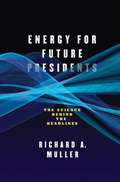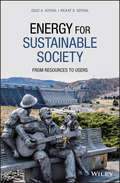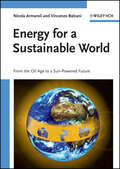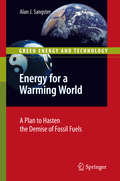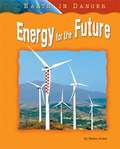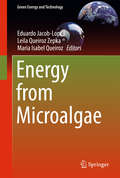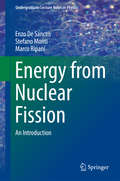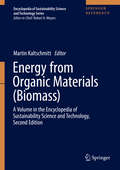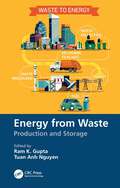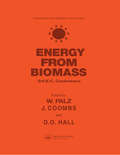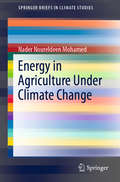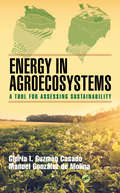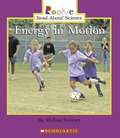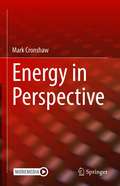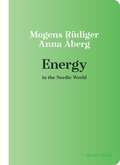- Table View
- List View
Energy and the Environment
by Robert A. Ristinen Jack J. Kraushaar Jeffrey T. BrackEnergy and the Environment Examine the tension between energy production and consumption and environmental conservation with the latest edition of this widely read text In the newly revised Fourth Edition of Energy and the Environment, the authors deliver an insightful and expanded discussion on the central topics regarding the interaction between energy production, consumption, and environmental stewardship. The book explores every major form of energy technology, including fossil fuels, renewables, and nuclear power, wrapping up with chapters on how energy usage affects our atmosphere, and the resulting global effects. The latest edition includes new figures and tables that reflect the most recent numbers on conventional and renewable energy production and consumption. The history and current status of relevant U.S. and international governmental energy legislation is discussed along with the text. Readers will also find: A thorough introduction to the fundamentals of energy and energy use in industrial societies, including the forms of energy, scientific notation, and the principle of energy conservation A comprehensive exploration of fossil fuels, including petroleum, coal, and natural gas, along with their history, world production, and remaining future resources Discussion of the pros and cons of nuclear power, it’s rise in China, and it’s fall elsewhere, and a history of power plant accidents A practical discussion of heat engines, including their thermodynamics, energy content of fuels, and heat pumps and engines In-depth examinations of new innovations and rapidly increasing use of renewable energy sources, including solar, wind, hydro, geothermal, and biomass energy, along with updates on battery technology and alternative energy storage techniques Detailed discussions of the atmospheric effects of our energy usage on scales both local and global; reports from the International Panel on Climate Change; the carbon budget, carbon capture and storage, and geoengineering Perfect for either graduate or upper-level undergraduate students of physics, environmental science, and engineering, Energy and the Environment is also an indispensable resource for anyone professionally or personally interested in climate change, energy policy, and energy conservation.
Energy and the Environment: Sources, Technologies, and Impacts
by Reza ToossiEnergy and the Environment is conceived and written at a level suitable for use as an introductory undergraduate textbook in energy and environment for students with very little mathematics or science background. It can also be used by anyone interested in technical, political, environmental, and economical issues related to energy. To make the text appropriate for engineering and science students, additional topics are included within information boxes placed throughout the book, and in the appendices. Examples requiring algebra are indicated in a similar manner. Depending on the audience, instructors can decide to eliminate all or part of this material without loss of continuity. Each chapter in Energy and the Environment stands alone, and the text can be taught in any order that the instructor deems suitable. Widely different curricula can therefore be designed and tailored for any audience simply by focusing on the appropriate sections from the appropriate chapters. For example, an environmental engineering course might include the summaries of various energy sources types, with an emphasis on air pollution, radiation, and environmental economics. A science curriculum might alternately emphasize the various technological sections and incorporate some of the engineering designs. This book is now available and can be purchased at http://vervepublishers.com. You may also order a free examination copy if you are considering adopting the Energy and the Environment for your classes. I would be most pleased to receive comments and thank you for your time!
Energy and the Quality of Life: Understanding Energy Policy
by Clifford Hooker Robert Macdonald Robert Van Hulst Peter VictorAs the supply/cost crunch tightens, issues related to energy become increasingly compelling. This is a guide for the general public to the fossil fuel crisis facing Canada, and Ontario in particular. It is also about other long-term matters of greater importance: the economic, socio-political, and cultural consequences of the choices which now have to be made, primarily by governments. The authors argue that energy policy is social policy. Therefore our ideas about the kind of society we want must be a governing consideration in working out a policy to take Canada through the energy crisis. The four writers bring to bear on the problem the perspectives of engineering, philosophy, environmental studies, and economics. The result is a balanced guide for the continuing debate on the adaptation of society to the imperatives of energy.
Energy and the Social Sciences: An Examination of Research Needs (Routledge Revivals)
by Sam H. Schurr Hans H. Landsberg John J. Schanz, Jr. Grant P. ThompsonOriginally published in 1974, this report dwells on the problems of meeting global energy demands and the time, effort and knowledge needed to research new energy methods. With rising costs, the uncertainty of supply from the Middle East and concern over the environmental impact of energy products, Energy and the Social Sciences outlines the intense need for well-designed research. This title will be of interest to students of Environmental Studies.
Energy and the Wealth of Nations
by Charles A. Hall Kent A. KlitgaardFor the past 150 years, economics has been treated as a social science in which economies are modeled as a circular flow of income between producers and consumers. In this "perpetual motion" of interactions between firms that produce and households that consume, little or no accounting is given of the flow of energy and materials from the environment and back again. In the standard economic model, energy and matter are completely recycled in these transactions, and economic activity is seemingly exempt from the Second Law of Thermodynamics. As we enter the second half of the age of oil, and as energy supplies and the environmental impacts of energy production and consumption become major issues on the world stage, this exemption appears illusory at best. In Energy and the Wealth of Nations, concepts such as energy return on investment (EROI) provide powerful insights into the real balance sheets that drive our "petroleum economy." Hall and Klitgaard explore the relation between energy and the wealth explosion of the 20th century, the failure of markets to recognize or efficiently allocate diminishing resources, the economic consequences of peak oil, the EROI for finding and exploiting new oil fields, and whether alternative energy technologies such as wind and solar power meet the minimum EROI requirements needed to run our society as we know it. This book is an essential read for all scientists and economists who have recognized the urgent need for a more scientific, unified approach to economics in an energy-constrained world, and serves as an ideal teaching text for the growing number of courses, such as the authors' own, on the role of energy in society.
Energy and the Wealth of Nations: Understanding The Biophysical Economy
by Charles A.S. Hall Kent KlitgaardIn this updated edition of a groundbreaking text, concepts such as energy return on investment (EROI) provide powerful insights into the real balance sheets that drive our “petroleum economy.” Hall and Klitgaard explore the relation between energy and the wealth explosion of the 20th century, and the interaction of internal limits to growth found in the investment process and rising inequality with the biophysical limits posed by finite energy resources. The authors focus attention on the failure of markets to recognize or efficiently allocate diminishing resources, the economic consequences of peak oil, the high cost and relatively low EROI of finding and exploiting new oil fields, including the much ballyhooed shale plays and oil sands, and whether alternative energy technologies such as wind and solar power can meet the minimum EROI requirements needed to run society as we know it.For the past 150 years, economics has been treated as a social science in which economies are modeled as a circular flow of income between producers and consumers. In this “perpetual motion” of interactions between firms that produce and households that consume, little or no accounting is given of the flow of energy and materials from the environment and back again. In the standard economic model, energy and matter are completely recycled in these transactions, and economic activity is seemingly exempt from the Second Law of Thermodynamics. As we enter the second half of the age of oil, when energy supplies and the environmental impacts of energy production and consumption are likely to constrain economic growth, this exemption should be considered illusory at best. This book is an essential read for all scientists and economists who have recognized the urgent need for a more scientific, empirical, and unified approach to economics in an energy-constrained world, and serves as an ideal teaching text for the growing number of courses, such as the authors’ own, on the role of energy in society.
Energy at the Crossroads
by Vaclav SmilIn Energy at the Crossroads, Vaclav Smil considers the twenty-first century's crucial question: how to reconcile the modern world's unceasing demand for energy with the absolute necessity to preserve the integrity of the biosphere. With this book he offers a comprehensive, accessible guide to today's complex energy issues -- how to think clearly and logically about what is possible and what is desirable in our energy future. After a century of unprecedented production growth, technical innovation, and expanded consumption, the world faces a number of critical energy challenges arising from unequal resource distribution, changing demand patterns, and environmental limitations. The fundamental message of Energy at the Crossroads is that our dependence on fossil fuels must be reduced not because of any imminent resource shortages but because the widespread burning of oil, coal, and natural gas damages the biosphere and presents increasing economic and security problems as the world relies on more expensive supplies and Middle Eastern crude oil. Smil begins with an overview of the twentieth century's long-term trends and achievements in energy production. He then discusses energy prices, the real cost of energy, and "energy linkages" -- the effect energy issues have on the economy, on quality of life, on the environment, and in wartime. He discusses the pitfalls of forecasting, giving many examples of failed predictions and showing that unexpected events can disprove complex models. And he examines the pros and cons not only of fossil fuels but also of alternative fuels such as hydroenergy, biomass energy, wind power, and solar power. Finally, he considers the future, focusing on what really matters, what works, what is realistic, and which outcomes are most desirable.
Energy at the Crossroads: Global Perspectives and Uncertainties (The\mit Press Ser.)
by Vaclav SmilAn objective, comprehensive, and accessible examination of today's most crucial problem: preserving the environment in the face of society's insatiable demand for energy.In Energy at the Crossroads, Vaclav Smil considers the twenty-first century's crucial question: how to reconcile the modern world's unceasing demand for energy with the absolute necessity to preserve the integrity of the biosphere. With this book he offers a comprehensive, accessible guide to today's complex energy issues—how to think clearly and logically about what is possible and what is desirable in our energy future.After a century of unprecedented production growth, technical innovation, and expanded consumption, the world faces a number of critical energy challenges arising from unequal resource distribution, changing demand patterns, and environmental limitations. The fundamental message of Energy at the Crossroads is that our dependence on fossil fuels must be reduced not because of any imminent resource shortages but because the widespread burning of oil, coal, and natural gas damages the biosphere and presents increasing economic and security problems as the world relies on more expensive supplies and Middle Eastern crude oil.Smil begins with an overview of the twentieth century's long-term trends and achievements in energy production. He then discusses energy prices, the real cost of energy, and "energy linkages"—the effect energy issues have on the economy, on quality of life, on the environment, and in wartime. He discusses the pitfalls of forecasting, giving many examples of failed predictions and showing that unexpected events can disprove complex models. And he examines the pros and cons not only of fossil fuels but also of alternative fuels such as hydroenergy, biomass energy, wind power, and solar power. Finally, he considers the future, focusing on what really matters, what works, what is realistic, and which outcomes are most desirable.
Energy for Development: Resources, Technologies, Environment
by Ferenc L. TothThis collection of contributions from a diverse group of prominent international scientists and policy makers brings together their in-depth analyses and innovative ideas about how to resolve the 'energy for development' predicament. It includes studies quantifying the role of energy in socioeconomic development, analysis of the interplay between supranational and national institutions in policy implementation, the energy implications of demographic trends such as urbanisation, and exploration of supply-side issues such as the potential role of nuclear energy and 'cleaning' fossil fuel energy generation through carbon capture.
Energy for Future Presidents: The Science Behind The Headlines
by Richard A. MullerThe author of Physics for Future Presidents returns to educate all of us on the most crucial conundrum facing the nation: energy. The near-meltdown of Fukushima, the upheavals in the Middle East, the BP oil rig explosion, and the looming reality of global warming have reminded the president and all U.S. citizens that nothing has more impact on our lives than the supply of and demand for energy. Its procurement dominates our economy and foreign policy more than any other factor. But the "energy question" is more confusing, contentious, and complicated than ever before. We need to know if nuclear power will ever really be safe. We need to know if solar and wind power will ever really be viable. And we desperately need to know if the natural gas deposits in Pennsylvania are a windfall of historic proportions or a false hope that will create more problems than solutions. Richard A. Muller provides all the answers in this must-read guide to our energy priorities now and in the coming years.
Energy for Future Presidents: The Science behind the Headlines
by Richard A. MullerThe near-meltdown of Fukushima, the upheavals in the Middle East, the BP oil rig explosion, and the looming reality of global warming have reminded the president and all U. S. citizens that nothing has more impact on our lives than the supply of and demand for energy. Its procurement dominates our economy and foreign policy more than any other factor. But the energy question is more confusing, contentious, and complicated than ever before. We need to know if nuclear power will ever really be safe. We need to know if solar and wind power will ever really be viable. And we desperately need to know if the natural gas deposits in Pennsylvania are a windfall of historic proportions or a false hope that will create more problems than solutions. Richard A. Muller provides all the answers in this must-read guide to our energy priorities now and in the coming years.
Energy for Sustainable Society: From Resources to Users
by Oguz A. Soysal Hilkat S. SoysalA handbook of sustainable energy, covering entire energy aspects from present status to future alternatives under one umbrella This book takes an interdisciplinary system approach to evaluating energy systems so that readers can gain the necessary technical foundation to perform their own performance evaluations and understand their interactions with socioeconomic indicators. Topics include the current and future availability of primary sources, energy supply chain, conversion between different forms of energy, security of energy supply, and efficient end-use of energy sources. Each chapter provides readers with comprehensive background information, an outline of the current technologies, and potential future developments. The book also examines the global, economic, societal, ethical, and environmental issues associated with currently used energy technologies. Energy for Sustainable Society: From Resources to Users starts with ageneral overview of energy systems, and describes the major elements of energy transformation and supply chain. It then discusses interdisciplinary career opportunities in the “energy engineering” field. The fundamental concepts of energy conversion, transmission, and load flow in electrical systems are covered, as are conventional and unconventional fossil fuels, and the basics of nuclear power generation and reactor types. Other chapters look at: the fundamental concepts of thermodynamics and basic operation of steam turbines, gas turbines, and combined cycle heat engines used in fossil fuel and nuclear power plants; current technologies in hydroelectric power generation; renewable and alternative energy sources; energy security issues; and more. Contains up-to-date information on renewable energy technologies such as grid-tie, net-zero energy, battery backup, and utility-independent micro grids Presents the status of the share of renewable sources in the current and future energy supply mix Provides solved examples, case studies, self-assessment quizzes, and problems to enhance the understanding of readers Includes an exclusive chapter on energy security issues Supplemented with a companion web site featuring a solutions manual, sample problems, and additional reading material Energy for Sustainable Society gives readers a solid foundation to study energy related subjects and is an ideal book for a first course on energy systems for upper division undergraduate and first year graduate students.
Energy for a Sustainable World: From the Oil Age to a Sun-Powered Future
by Vincenzo Balzani Nicola ArmaroliAn easy read, balancing the pros and cons, this book surveys the energy issue from a broad scientific perspective while considering environmental, economic, and social factors. It explains the basic concepts, provides a historical overview of energy resources, assesses our unsustainable energy system based on fossil fuels, and shows that the energy crisis is not only a tough challenge, but also an unprecedented opportunity to become more concerned about the world in which we live and the society we have built up. By outlining the alternatives for today and the future, it gives an extensive overview on nuclear energy, solar thermal and photovoltaics, solar fuels, wind power, ocean energies and other renewables, highlighting the increasing importance of electricity and the long-term perspectives of a hydrogen-based economy. An excellent source of updated and carefully documented information on the entangled aspects of the energy issue, this book is a guide for scientists, students and teachers looking for ways out of the energy and climate crisis, and the problems and disparities generated during the fossil fuel era.
Energy for a Warming World
by Alan John Sangster"Energy for a Warming World" challenges the commonplace notion that the amount of power which mankind can potentially harness from renewable resources is more than large enough to assuage future demand levels. By examining the renewable issue from an electrical engineering perspective, and exercising due regard for the limited capability of current and future electrical generation and transmission systems, this book attempts to provide more realistic statistics for the levels of power which could be extracted from sustainable resources in the critical time frame of 30 to 40 years. The engineering logic leads inexorably to the importance of taking a global outlook on the switch to renewable power supply and transmission - an outlook which has some surprising and uncomfortable ramifications for mankind. "Energy for a Warming World" provides a new perspective on renewable resources for academics and researchers in environmental or electrical power engineering, as well as to students in related areas.
Energy for the Future (Earth in Danger)
by Helen OrmeBurning fossil fuels, such as oil and coal, may be accelerating Earth's climate change. How can we develop clean, renewable sources of energy and reduce our dependence on fossil fuels? Energy for the Future clearly presents the pros and cons of alternative energy sources-- from wind, water, and solar power to bio-fuels, hydrogen fuel cells, and nuclear power. A section in the back of the book will inspire young environmentalists by suggesting ways they can help protect their planet.
Energy from Microalgae (Green Energy And Technology)
by Eduardo Jacob-Lopes Leila Queiroz Zepka Maria Isabel QueirozThis book presents an authoritative and comprehensive overview of the production and use of microalgal biomass and bioproducts for energy generation. It also offers extensive information on engineering approaches to energy production, such as process integration and process intensification in harnessing energy from microalgae. Issues related to the environment, food, chemicals and energy supply pose serious threats to nations’ success and stability. The challenge to provide for a rapidly growing global population has made it imperative to find new technological routes to increase the production of consumables while also bearing in mind the biosphere’s ability to regenerate resources. Microbial biomass is a bioresource that provides effective solutions to these challenges.Divided into eight parts, the book explores microalgal production systems, life cycle assessment and the bio-economy of biofuels from microalgae, process integration and process intensification applied to microalgal biofuels production. In addition, it discusses the main fuel products obtained from microalgae, summarizing a range of useful energy products derived from algae-based systems, and outlines future developments. Given the book’s breadth of coverage and extensive bibliography, it offers an essential resource for researchers and industry professionals working in renewable energy.
Energy from Nuclear Fission
by Enzo Sanctis Stefano Monti Marco RipaniThis book provides an overview on nuclear physics and energy production from nuclear fission. It serves as a readable and reliable source of information for anyone who wants to have a well-balanced opinion about exploitation of nuclear fission in power plants. The text is divided into two parts; the first covers the basics of nuclear forces and properties of nuclei, nuclear collisions, nuclear stability, radioactivity, and provides a detailed discussion of nuclear fission and relevant topics in its application to energy production. The second part covers the basic technical aspects of nuclear fission reactors, nuclear fuel cycle and resources, safety, safeguards, and radioactive waste management. The book also contains a discussion of the biological effects of nuclear radiation and of radiation protection, and a summary of the ten most relevant nuclear accidents. The book is suitable for undergraduates in physics, nuclear engineering and other science subjects. However, the mathematics is kept at a level that can be easily followed by wider circles of readers. The addition of solved problems, strategically placed throughout the text, and the collections of problems at the end of the chapters allow readers to appreciate the quantitative aspects of various phenomena and processes. Many illustrations and graphs effectively supplement the text and help visualising specific points.
Energy from Organic Materials (Encyclopedia Of Sustainability Science And Technology Ser.)
by Martin KaltschmittThis comprehensive reference is a state-of-the-art survey of biomass as an energy carrier for the provision of heat, electricity, and transportation fuel, considering technical, economic, environmental, and social aspects. On a global scale, biomass contributes roughly 12 to 16 % of the energy needed to cover the overall primary energy consumption. Thus far, it is humanity’s most important source of renewable energy, used on practically all continents and growing in importance even in industrialized nations. With detailed coverage of the production of solid, gaseous and liquid fuels, as well as a final energy provision, this volume serves as an introduction for readers just entering the field, but also offers new insights, up-to-date information, as well as latest findings for advanced researchers, industry experts, and decision makers.
Energy from Waste: Production and Storage
by Ram K. GuptaConversion of waste into value-added products such as energy transforms a potential environmental problem into a sustainable solution. Energy from Waste: Production and Storage focuses on the conversion of waste from various sources for use in energy production and storage applications. It provides the state-of-the-art in developing advanced materials and chemicals for energy applications using wastes and discusses the various treatment processes and technologies. Covers synthesis of usable materials from various types of waste and their application in energy production and storage Presents an overview and applications of wastes for green energy production and storage Provides fundamentals of electrochemical behavior and understanding of energy devices such as fuel cells, batteries, supercapacitors, and solar cells Elaborates on advanced technologies used to convert waste into green biochemical energy This work provides new direction to scientists, researchers, and students in materials and chemical engineering and related subjects seeking to sustainable solutions to energy production and waste management.
Energy from the Biomass: Third EC conference
by W. Palz J. Coombs D. O. HallThis book is based on third European Conference on Energy from Biomass held in Venice. It covers energy security, environmental aspects, relieving the overproduction in some agricultural sectors and creation of jobs in rural areas.
Energy in Agriculture Under Climate Change (SpringerBriefs in Climate Studies)
by Nader Noureldeen MohamedThis book discusses the role of energy in agriculture which reaches 30%, and the role of agriculture in energy where the water shred by 17% in total electricity generation in addition to the role of bioenergy as a source of liquid energy. Climate change and global heating will increase the temperature and that will affect plant growth, water availability and the share of electricity in agriculture and other energy phases in agriculture. Global heating means more water pumping, more uses of fertilizers and pesticides in which intensive power consumption in addition to need of more electricity for air-condition inside the greenhouses, the manufacturing of hormone and plant growth organizers will also consume more energy. Finally, the book explains why the water, energy and food become one nexus and the interaction and interference between them.This book will have valuable information for both students and faculties of engineering and agriculture in addition to research centers, water institutions and climate change specialists.
Energy in Agroecosystems: A Tool for Assessing Sustainability (Advances in Agroecology)
by Gloria I. Casado Manuel Gonzalez de MolinaEnergy in Agroecosystems: A Tool for Assessing Sustainability is the first book on energy analysis that is up-to-date and specifically dedicated to agriculture. It is written from an agroecological perspective and goes beyond the conventional analysis of the efficient use of energy. The book provide a methodological guide to assess energy efficiency and sustainability from an eco-energetic point of view. <P><P> Case studies from both Europe and America, which are representative of today’s most used scales of analysis (crop, farm, local or national) and the different farm management practices (traditional, industrialized, and contemporary organic), apply this methodology This book will be of primary interest to researchers, practitioners, and students working in the areas of agroecology, sustainable agriculture, environmental science, energy analysis, natural resources management, rural development and international development.
Energy in Motion
by Melissa StewartThis is a science book meant for children and introduces energy through motion using common objects around us.
Energy in Perspective
by Mark CronshawThis textbook provides broad coverage of energy supply and use. It discusses how energy is produced, transformed, delivered to end users, and consumed. The author discusses all of this at an undergraduate level, accessible to students of varying backgrounds. High-level and human-scale perspectives are included. As a high-level example, the book discusses the shares of global primary energy that are provided by oil, gas, coal, hydroelectricity, and renewables, as well as trends in energy consumption and supply over time. Human-scale examples will resonate with readers’ every day experiences. The link between economic development and energy consumption is presented, which facilitates understanding of how global energy consumption growth is inevitable as economic development occurs. Coverage includes separate chapters on the oil, natural gas, coal, and electricity sectors. Each of these provides high-level descriptions of the technology involved in the production of that type of energy as well as the processing and transportation that occurs to bring the energy to end users. The book discusses the technological implications of energy transitions such as increased use of renewables or changes in the use of nuclear energy using Germany and Japan as examples. It closes with a discussion of future energy use.
Energy in the Nordic World (Nordic World)
by Mogens Rüdiger Anna ÅbergNorway and Sweden are among the biggest consumers of energy per capita, yet the Nordic nations also lead the world in clean power production and have ambitious goals of decarbonizing their energy systems by 2050. Denmark, Norway, Sweden, Finland, and Iceland vary drastically in geography and the availability of natural resources, but each consistently generates electricity from renewable sources at multiple times the average rate of other high-income countries. Mogens Rüdiger and Anna Åberg present a concise and timely history of energy production, trade, and consumption in Norden, starting with a review of the regional energy mix—from wind, solar, tide and wave, geothermal, biomass, nuclear, coal, and gas sources. Brief chapters describe the diversity of Nordic energy markets, assess how far the green transition has come, and explore what comes next as global crises, domestic politics, and technological developments present novel challenges and opportunities. Energy infrastructures and economic activities, Rüdiger and Åberg argue, serve as unique cultural focal points in the region. The coauthors summarize the national policy frameworks for the sector as well as the key energy and economic indicators used in infrastructure planning, regulation, and the opening of the electricity and gas markets to free competition. Energy in the Nordic World is the essential primer to the power markets at the heart of Europe’s energy transition.
